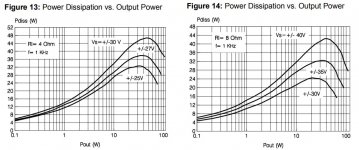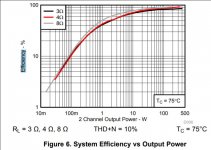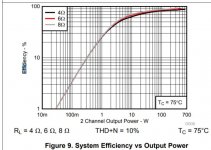Same here. Realised after years my big Denon AV amp sounded crap if listening critically. Muddy, no separation, congested sound.
Added 3e 3255 for the front channels....AVR still as preamp and sound was much better. Added a small passive pre and some cables to allow music through dac and bypassing AVR so just 3255 in play and it has never sounded better.
Even £4 tda8932 sound good!
Added 3e 3255 for the front channels....AVR still as preamp and sound was much better. Added a small passive pre and some cables to allow music through dac and bypassing AVR so just 3255 in play and it has never sounded better.
Even £4 tda8932 sound good!
I have several class AB amplifiers, DIY constructions and commercial products, and a number of DIY class D amplifiers. Some of my DIY Class AB and DIY class D amplifiers sound great, other a little less. My wife prefers the commercial ones because at least they are presentable in the living room. None of the commercial ones sound as good as the better DIY amplifiers.
I bought a defect Denon AV amplifier with the (naive) hope to repair it. When I opened it up, I realized that there were components in numbers I could not have imagined and functional blocks I would not have expected. The power supply was no doubt on par with such good quality commercial products but I could do better. I gave up doing a repair and took it apart as I found many interesting components, such as the transformer, I may use for DIY. I will not advice anybody to assume that they can repair or modify an AVR amplifier simply because of the complex structure and number of components. AVR amplifiers are great for your home cinema and for background music on a cosy evening. You cannot make an AVR amplifier yourself and they are actually cheap for the lot that is inside. But, they are not made for critical music listening.
There is a simple fact to remember - no electronic part or building block remove distortion from the original source signal. They only add distortion. Inside an AVR amplifier, the signal is routed around in a manner I dare not think of and even if all building blocks are well made, they all add distortion.
As "jimk04" confirms, good sound means as few high quality building blocks as possible logically leaves the best sound. What do we need? A high quality source, a simple volume control (eventually passive) and a high quality power amplifier (+speakers evidently), that's all. I know that a remote volume control is convenient but it adds distortion (unless a motorized potentiometer is used). Some like equalizers (tone control) but distortion wise they are heavy.
Like top quality gear has been made for long, keep it simple but with the few building blocks you really need of high(est) quality. One reason why DIY audio gear is worth the effort. A class AB or class D power amplifier is a secondary issue.
I bought a defect Denon AV amplifier with the (naive) hope to repair it. When I opened it up, I realized that there were components in numbers I could not have imagined and functional blocks I would not have expected. The power supply was no doubt on par with such good quality commercial products but I could do better. I gave up doing a repair and took it apart as I found many interesting components, such as the transformer, I may use for DIY. I will not advice anybody to assume that they can repair or modify an AVR amplifier simply because of the complex structure and number of components. AVR amplifiers are great for your home cinema and for background music on a cosy evening. You cannot make an AVR amplifier yourself and they are actually cheap for the lot that is inside. But, they are not made for critical music listening.
There is a simple fact to remember - no electronic part or building block remove distortion from the original source signal. They only add distortion. Inside an AVR amplifier, the signal is routed around in a manner I dare not think of and even if all building blocks are well made, they all add distortion.
As "jimk04" confirms, good sound means as few high quality building blocks as possible logically leaves the best sound. What do we need? A high quality source, a simple volume control (eventually passive) and a high quality power amplifier (+speakers evidently), that's all. I know that a remote volume control is convenient but it adds distortion (unless a motorized potentiometer is used). Some like equalizers (tone control) but distortion wise they are heavy.
Like top quality gear has been made for long, keep it simple but with the few building blocks you really need of high(est) quality. One reason why DIY audio gear is worth the effort. A class AB or class D power amplifier is a secondary issue.
Last edited:
efficiencY of AB amps vs Class D amps
Hi
according tot that sheets both are not very sufficient for less power
TDA7294 e.g. 4R 12Watt dissapation but 1 Watt ouput power at 27V rail --> e = Pout/ Pin = 1/12 = 0,08
TPA3251
TPA3255
chris
Hi
according tot that sheets both are not very sufficient for less power
TDA7294 e.g. 4R 12Watt dissapation but 1 Watt ouput power at 27V rail --> e = Pout/ Pin = 1/12 = 0,08
TPA3251
TPA3255
chris
Attachments
Last edited:
Hi
according tot that sheets both are not very sufficient for less power
TDA7294 e.g. 4R 12Watt dissapation but 1 Watt ouput power at 27V rail --> e = Pout/ Pin = 1/12 = 0,08
TPA3251
TPA3255
chris
How do you else heat your living-room in the cold winter evenings (no Stroh rum)?
Chris, if you calculate the efficiency of a TPA3255 at 1W out when you include idle losses, the calculation is not that pretty either. Let's hope nobody finds out that the big climate crooks are the DIYs.
Last edited:
I always knew Austria was the cause for climate change. My calculations show, if Austria would stop any use of energy, right now, with not even one inhabitant even smoking a cigarette or eating a piece of meat, we could delay the climate change.
For exactly 1 hour and 25 minutes, 11 seconds. Ask Greta Thunfish, she knows!
So taking away any DIYS stuff form these energy wasters, world wide, would help the world climate, talking in time, about 35 micro seconds.
So, please, for the climates sake, let´s shut down this forum!
For exactly 1 hour and 25 minutes, 11 seconds. Ask Greta Thunfish, she knows!
So taking away any DIYS stuff form these energy wasters, world wide, would help the world climate, talking in time, about 35 micro seconds.
So, please, for the climates sake, let´s shut down this forum!
...As "jimk04" confirms, good sound means as few high quality building blocks as possible logically leaves the best sound. What do we need? A high quality source, a simple volume control (eventually passive) and a high quality power amplifier (+speakers evidently), that's all.


In my youth, the first CD was the turning point for HIFI. After years of people being proud of having a hole corner full of different gear cabled up, I and a lot of other people, realized that all this stuff didn't help much with sound.
My first CD player had two outputs, one went over a mechanical potentiometer, one direct.
I spent, if I remember right, two years trying different pre-amps, until I found one that had no sound added or removed from the signal. I could live even without a pre for listening, but as I build speakers, I needed a balance and mono function for A/B comparisons.
The one I found had exactly what I needed and was on sale for a ridiculous price. Most important was the mono switch and for real listening, the option to take all tremble, bass, loudness out of the way. Was a Fisher CC-3000. I still use it.
The next pre-amp that came in at par was an AVM Evolution V1 in 1992. Still in use at a friend of mine. These are very basic amps, reduced to some relays and a simple adjustable power stage with high voltage output.
The often used passive pre is only a solution for some cases, as many amps do not like to be driven by a resistor (pot).
So yes, keep it simple, keep (cables) it short.
The AVR´s bad sound is not with all of them. There are very good sounding AVR´s on the market. It depends on how you use them, too. Today you will not get around DSP processing, somewhere in the chain. At last the producer of your source used one...
So, these bashing digital equipment are on the wrong way. It is, IMO, better to sent your signal through some DSP and let it do the separation of frequency, than to use 3 pounds or more of passive L, R and C to do the job.
Yes, not too much stages, but enough to get a good result. Even as there might not be two people in the world selecting the same components for this task...
so what will be the final result?
My first CD player had two outputs, one went over a mechanical potentiometer, one direct.
I spent, if I remember right, two years trying different pre-amps, until I found one that had no sound added or removed from the signal. I could live even without a pre for listening, but as I build speakers, I needed a balance and mono function for A/B comparisons.
The one I found had exactly what I needed and was on sale for a ridiculous price. Most important was the mono switch and for real listening, the option to take all tremble, bass, loudness out of the way. Was a Fisher CC-3000. I still use it.
The next pre-amp that came in at par was an AVM Evolution V1 in 1992. Still in use at a friend of mine. These are very basic amps, reduced to some relays and a simple adjustable power stage with high voltage output.
The often used passive pre is only a solution for some cases, as many amps do not like to be driven by a resistor (pot).
So yes, keep it simple, keep (cables) it short.
The AVR´s bad sound is not with all of them. There are very good sounding AVR´s on the market. It depends on how you use them, too. Today you will not get around DSP processing, somewhere in the chain. At last the producer of your source used one...
So, these bashing digital equipment are on the wrong way. It is, IMO, better to sent your signal through some DSP and let it do the separation of frequency, than to use 3 pounds or more of passive L, R and C to do the job.
Yes, not too much stages, but enough to get a good result. Even as there might not be two people in the world selecting the same components for this task...
so what will be the final result?
- Status
- This old topic is closed. If you want to reopen this topic, contact a moderator using the "Report Post" button.
- Home
- Amplifiers
- Class D
- Class D vs Class AB




